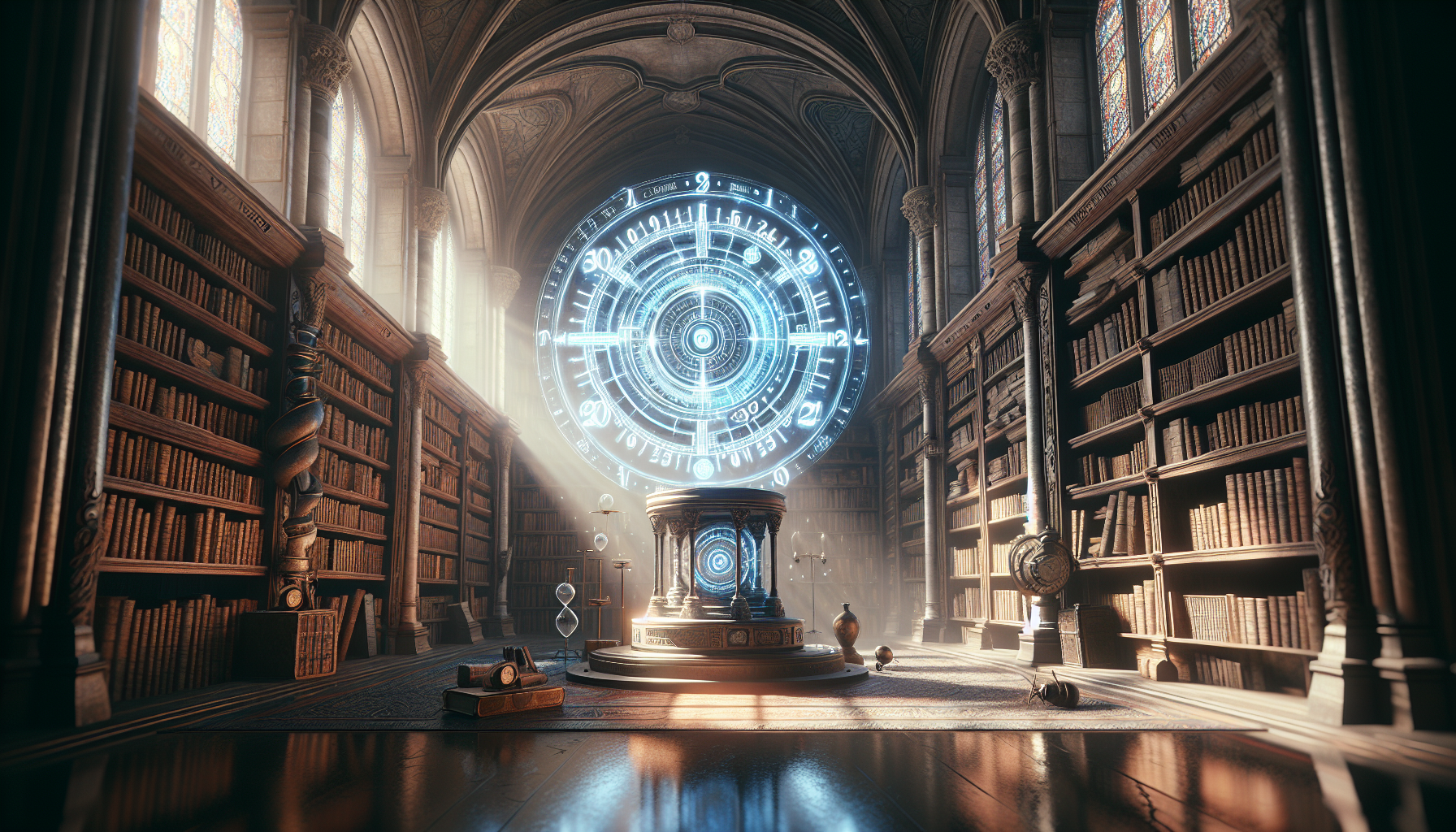In the heart of Rome, shrouded in mystery and religious grandeur, lies the Vatican City—a place synonymous with spiritual leadership and historical intrigue. Among the many secrets rumored to be held within its ancient walls, one stands out for its fascinating blend of science fiction and conspiracy theory: the Chronovisor. This alleged device is said to enable its user to view past events, thus opening a window into history itself. 🕰️ While the existence of the Chronovisor is often dismissed as mere legend, the stories surrounding it invite us to delve into the possibilities of time travel and the hidden narratives of our past. Welcome to an exploration of one of the Vatican’s most captivating enigmas.
As we embark on this journey, it’s important to separate fact from fiction, myth from reality. The Chronovisor is said to have been invented by Father Pellegrino Maria Ernetti, a Benedictine monk with a profound interest in both music and physics. According to various accounts, Ernetti collaborated with a team of world-renowned scientists in the mid-20th century to develop this extraordinary device. The Chronovisor reportedly operated by detecting and amplifying residual electromagnetic radiation left by historical events, projecting them onto a screen for observers to witness. Imagine the possibilities: standing in the Colosseum as gladiators battle, witnessing the signing of the Magna Carta, or even watching a sermon delivered by Jesus Christ himself. The Chronovisor, if real, could offer unprecedented insights into the annals of human history.
But what does this mean for our understanding of time? The concept of time travel has long captivated the human imagination, from H.G. Wells’ iconic “The Time Machine” to modern-day science fiction. Yet, the idea of peering into the past without physically traveling through time presents an intriguing twist. It suggests that every moment in history leaves an indelible mark, a footprint in the fabric of the universe that can be observed and studied. This notion challenges our linear perception of time, proposing instead that the past, present, and future might coexist in a complex, interconnected tapestry. Such ideas not only tantalize the imagination but also push the boundaries of contemporary science and philosophy.
Our exploration will delve into the origins of the Chronovisor legend, examining the historical context in which it emerged and the key figures purportedly involved in its creation. We’ll assess the credibility of the evidence presented and explore the broader implications of such a device on our understanding of history and time. Additionally, we’ll consider the perspectives of skeptics and believers alike, analyzing how cultural, religious, and scientific viewpoints shape the narrative surrounding the Chronovisor. By the end of this article, we aim to provide a comprehensive overview that illuminates this intriguing intersection of faith, science, and the unknown.
As we unravel the threads of this mysterious tale, we invite you to consider the deeper questions it raises: How do we distinguish between myth and reality? What are the ethical implications of having the power to observe—or potentially alter—the past? And ultimately, what does this tell us about the nature of human curiosity and our unending quest for knowledge? Join us as we unlock the mysteries of the Vatican’s Chronovisor, exploring the legends of time travel and the secret histories it may reveal. 🌟
Unveiling the Enigma: The Origin and History of the Chronovisor
The Vatican’s Chronovisor has long been shrouded in mystery and intrigue, a device purportedly capable of peering into the past. The legend begins in the early 1960s, when Italian priest and scientist Father Pellegrino Ernetti allegedly invented this remarkable machine. Ernetti claimed that the Chronovisor could visualize past events in real-time, making it a powerful tool for historians, archaeologists, and theologians alike. Despite the sensational nature of these claims, the Vatican has remained characteristically tight-lipped, neither confirming nor denying the existence of such a device.
The story of the Chronovisor is not just about time travel; it is deeply intertwined with the cultural and scientific milieu of the 20th century. As we delve into the origins of this mysterious device, we must consider the context in which it was conceived. The post-war period was a time of rapid technological advancement and scientific exploration. It was also an era marked by a renewed interest in the metaphysical and the mystical, as people sought new ways to understand and engage with the world around them. The Chronovisor fits neatly into this narrative, embodying the collision of science, religion, and speculative fiction.
Father Ernetti claimed that he collaborated with a team of twelve scientists, including Nobel laureate Enrico Fermi and aerospace engineer Wernher von Braun, to develop the Chronovisor. This eclectic group of intellectuals supposedly pooled their knowledge of quantum physics, electromagnetism, and ancient religious texts to bring the device to life. While there is scant evidence to support these claims, the allure of such a powerful device, capable of unlocking the secrets of history, has captured the imagination of many. As we explore the origins and history of the Chronovisor, it is important to remain critical and consider the broader implications of its alleged existence.
The Mechanics of Time Travel: How the Chronovisor is Supposed to Work
Understanding how the Chronovisor is supposed to function requires delving into the theoretical underpinnings of time travel. According to Father Ernetti, the device operates on the principle that all past events leave a residual energy trace in the form of electromagnetic waves. These waves, he posited, could be captured and reconstructed into visual and auditory representations of historical events. The Chronovisor, therefore, functions as a sophisticated receiver and converter of these energy patterns, allowing users to ‘see’ the past.
This concept draws heavily from the ideas of quantum physics and electromagnetism, fields that were undergoing significant developments in the mid-20th century. The theoretical possibility of time travel had been a topic of scientific debate for decades, with physicists exploring the implications of Einstein’s theory of relativity and the potential for wormholes or ‘Einstein-Rosen bridges’ to serve as shortcuts through spacetime. While the Chronovisor’s supposed mechanism is speculative at best, it is rooted in these broader scientific discussions, lending an air of plausibility to the otherwise fantastical claims.
The purported technology behind the Chronovisor also raises interesting philosophical and ethical questions. If we accept the possibility of viewing past events, what are the implications for our understanding of history and our responsibility to preserve it? Moreover, how do we reconcile the existence of such a device with the Vatican’s religious teachings and the broader moral considerations of time travel? As we examine the mechanics of the Chronovisor, it is essential to consider these deeper questions and the potential consequences of its use.
Exploring the Claims: The Evidence for and Against the Chronovisor
Over the years, numerous claims and counterclaims have surfaced regarding the existence and functionality of the Chronovisor. One of the most significant pieces of ‘evidence’ put forth by Father Ernetti was a photograph allegedly taken by the device, depicting the crucifixion of Jesus Christ. This image, however, was later debunked as a reproduction of a statue from an Italian church, casting doubt on the credibility of Ernetti’s assertions.
Moreover, skeptics argue that the lack of verifiable evidence supporting the Chronovisor’s existence is a strong indicator that it is little more than a myth. Despite Ernetti’s claims of collaboration with renowned scientists, no corroborating accounts or documentation have emerged to substantiate this narrative. Furthermore, the Vatican has never officially acknowledged the device, maintaining a position of silence on the matter.
On the other hand, some proponents argue that the secrecy surrounding the Chronovisor is precisely what one would expect if such a device were real. They suggest that the potential implications of time travel—ranging from the ability to alter historical events to the ethical dilemmas it presents—would necessitate extreme confidentiality. While this line of reasoning is speculative, it highlights the ongoing fascination and debate surrounding the Chronovisor and its potential impact on our understanding of history and the nature of time itself.
Comparing Theories: Time Travel in Science Fiction vs. The Chronovisor
To better understand the place of the Chronovisor in the broader context of time travel narratives, it is useful to compare it to the treatment of time travel in science fiction. Unlike the instantaneous and often whimsical time travel portrayed in movies and literature, the Chronovisor offers a more grounded and scientifically plausible approach, at least in theory. This distinction is important, as it highlights the unique position the Chronovisor occupies between the realms of science and speculative fiction.
| Aspect | Science Fiction Time Travel | Chronovisor |
|---|---|---|
| Mechanism | Varies widely, often includes machines or portals | Relies on electromagnetic waves and quantum physics |
| Purpose | Entertainment, exploration of paradoxes | Historical observation, potential academic use |
| Implications | Often explores paradoxes, ethical dilemmas | Focuses on historical accuracy and religious implications |
As you examine the table above, consider how the unique characteristics of the Chronovisor compare to those of traditional time travel narratives. This comparison underscores the distinct role the device plays in the ongoing conversation about time travel and its implications for our understanding of reality. For a more immersive experience, watch this video on time travel theories and how they relate to the Chronovisor’s claims.
The Cultural and Religious Implications of the Chronovisor
The potential existence of a device like the Chronovisor carries profound cultural and religious implications. For the Vatican, a tool capable of verifying historical religious events could provide incontrovertible evidence of biblical narratives, reshaping the foundation of faith for millions. However, such a device also poses significant challenges, as it might expose inconsistencies or contradictions in religious texts, prompting theological debates and potential crises of faith.
From a cultural perspective, the ability to view past events holds the promise of revolutionizing our understanding of history. Historians and archaeologists could confirm or refute long-standing theories, leading to a more accurate and nuanced understanding of the past. Yet, this newfound clarity comes with its own set of ethical dilemmas, as the power to observe history raises questions about the privacy of past individuals and the potential for misuse of historical knowledge.
The Chronovisor’s implications extend beyond the realm of academia and religion, touching on broader philosophical questions about the nature of time and existence. If we accept the possibility of time travel, we must also reconsider our understanding of causality and the linear progression of events. The Chronovisor, therefore, serves as a catalyst for deeper reflection on these fundamental aspects of human existence, inviting us to grapple with the mysteries of time and the stories it holds.
Engaging with the Mysteries: Further Exploration and Discussion
As the debate over the Chronovisor continues, it is essential for scholars, theologians, and curious minds alike to engage with the questions it raises. By fostering open discussions and encouraging interdisciplinary collaboration, we can explore the potential implications of such a device and better understand its place within the broader context of human knowledge.
For those interested in diving deeper into the mysteries of the Chronovisor, consider exploring related works in science fiction, philosophy, and religious studies. These fields offer valuable insights into the broader themes and implications of time travel, providing a richer understanding of the device’s potential impact.
Finally, as you ponder the mysteries of the Chronovisor, remember that the pursuit of knowledge is an ongoing journey. By remaining curious and open to new ideas, we can continue to unlock the secrets of history and time, one discovery at a time.
- Explore further with books on time travel and its implications.
- Join online forums and discussion groups to share insights and theories.
- Attend lectures or webinars on the intersection of science, religion, and history.

Conclusion
Conclusion: Unlocking the Mysteries of the Vatican’s Chronovisor
In exploring the legends and mysteries surrounding the Vatican’s Chronovisor, we have traversed a landscape rich with intrigue, historical speculation, and the tantalizing possibility of time travel. This exploration not only invites us to ponder the existence of such a device but also challenges us to reflect on the boundaries between science, faith, and myth. Throughout this article, we have examined the origins of the Chronovisor legend, delved into the claims and controversies surrounding its purported capabilities, and considered the broader implications such a device would have on our understanding of history and human experience.
The legend of the Chronovisor finds its roots in the mid-20th century, when Father Pellegrino Ernetti, a Benedictine monk and scientist, allegedly developed the device with a team of world-renowned scientists, including Nobel laureate Enrico Fermi. The Chronovisor was claimed to be able to capture and reproduce scenes from the past, offering a window into historical events and moments otherwise lost to time. While many dismiss these claims as mere fiction or fabrication, the allure of the Chronovisor persists, feeding the imaginations of those who wish to believe in the possibility of transcending time.
Our exploration also highlighted the skepticism and criticism faced by the Chronovisor narrative. Historians and scientists alike question the feasibility of such technology, pointing to the lack of empirical evidence and the absence of verifiable demonstrations as critical shortcomings. Despite these challenges, the story of the Chronovisor serves as a powerful reminder of humanity’s enduring fascination with the mysteries of time and the potential to unlock its secrets.
The significance of the Chronovisor legend extends beyond the mere possibility of time travel; it touches on the profound human desire to connect with the past and uncover hidden truths. The notion of accessing pivotal moments in history and witnessing them firsthand could revolutionize our understanding of historical narratives and challenge the very nature of reality as we know it. This profound impact would inevitably raise ethical questions about privacy, the preservation of history, and the potential misuse of such technology.
In contemplating the broader themes of this article, we must acknowledge the importance of critical thinking and open-minded exploration. While the legend of the Chronovisor may never be substantiated, it serves as an invitation to question and seek knowledge beyond the boundaries of conventional understanding. The allure of time travel, the potential to rewrite history, and the quest for hidden truths resonate with our innate curiosity and desire for discovery.
As we conclude this exploration of the Vatican’s Chronovisor, we encourage you, our readers, to continue the conversation. Whether you are a skeptic or a believer, your insights and perspectives enrich the dialogue surrounding this enigmatic topic. Share this article with friends and family who may also be intrigued by the mysteries of time and history. Engage in discussions that challenge your perspectives and broaden your horizons. The pursuit of knowledge is a collaborative journey, and your participation is invaluable.
🔗 History and Mystery: Exploring the Chronovisor Legend
🔗 The Science Behind Time Travel Theories
Thank you for joining us on this journey into the mysteries of the Vatican’s Chronovisor. Your curiosity and engagement are the keys to unlocking the secrets of time and history. 🌟
Toni Santos is a visual storyteller and conceptual archivist whose work explores the curious, often poetic ruins of pseudoscience and obsolete theories. With a reverence for forgotten frameworks and fantastical logic, Toni illuminates the imaginative spaces where science once drifted into myth, speculation, and symbolic belief.
His creative path is rooted in a fascination with the fringe — from phrenology maps to ether diagrams, hollow earth charts to animal magnetism illustrations. Each visual Toni creates or curates is an invitation to reexamine the strange beauty of discarded knowledge — not as failure, but as cultural reflection, as art born from our eternal desire to explain the unexplainable.
Blending visual design with historical inquiry, Toni gives new life to lost diagrams, metaphysical charts, and antique engravings that once shaped worldviews. His work occupies the liminal zone between fact and fiction, where obsolete models still pulse with philosophical resonance and forgotten charm.
As the mind behind Vizovex, Toni shares illustrated essays, curated collections, and visual reinterpretations that invite others to explore the aesthetic and symbolic value of outdated theories. His goal is not to validate, but to remember — to view these speculative systems as relics of human creativity, vulnerability, and yearning.
His work is a tribute to:
The elegance of error in the evolution of knowledge
The symbolic artistry of discarded explanations
The blurred lines between belief, observation, and imagination
Whether you’re a collector of curious ideas, a lover of forgotten diagrams, or someone drawn to the strange scaffolding of old worldviews, Toni opens a portal to a time when the universe was still full of ghosts, humors, and cosmic fluids — one chart, one symbol, one discredited wonder at a time.





